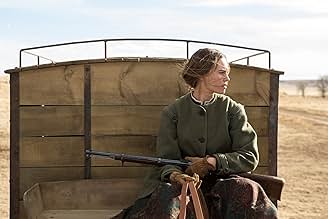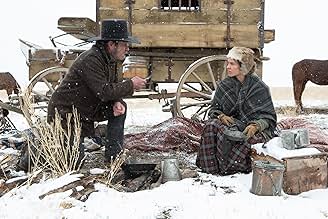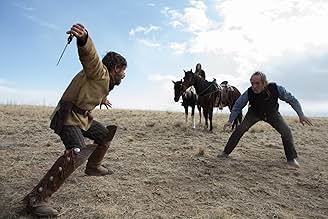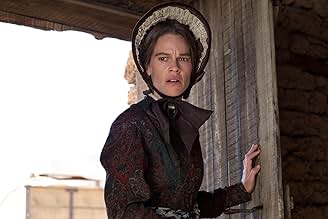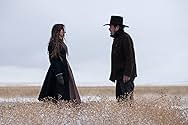Drei Frauen, die vom Pionierleben in den Wahnsinn getrieben wurden, sollen von der frommen, unabhängigen Mary Bee Cuddy mit Planwagen durchs Land befördert werden. Sie bittet George Briggs u... Alles lesenDrei Frauen, die vom Pionierleben in den Wahnsinn getrieben wurden, sollen von der frommen, unabhängigen Mary Bee Cuddy mit Planwagen durchs Land befördert werden. Sie bittet George Briggs um Hilfe.Drei Frauen, die vom Pionierleben in den Wahnsinn getrieben wurden, sollen von der frommen, unabhängigen Mary Bee Cuddy mit Planwagen durchs Land befördert werden. Sie bittet George Briggs um Hilfe.
- Auszeichnungen
- 5 Gewinne & 14 Nominierungen insgesamt
Empfohlene Bewertungen
Tommy Lee Jones has a wry, dry character -- rich and deep as unwatered open plains of the Americas. He's transferred his particular personality power to the story of The Homesman. He's successfully created a fine work of "auteur cinema" (much as I personally think this form rarely exists).
The Homesman is an emotionally and powerful, idea-rich, almost humorless story -- with an immense amount of humor. It has very tight, economic tale telling with no fat on the bone; in which much is implied, historical accuracy hits its target by nuance, and the story itself is deeply respectful of an intelligent audience.
The Homesman is not "entertainment" in the haha, shoot-'em-up Western sense. It's realism committed to a moral cause -- criticism of the disenfranchised, the homeless, the people who cannot make it no matter how hard they try. It has a brilliant sense of time and place that tells the life stories of dozens of hard-enduring, long-suffering "forgotten men" -- the women no less than the men.
The key heartbreaker is Hilary Swank's character of Miss Mary Bee Cuddy. She's born into a Western frontier world where she and everyone else believes and practices that "No man, having put his hand to the plough, and looking back, is fit for the kingdom of God." Hard workers and decent people. But tragically that is not enough. Why? The Homesman leaves that question deliciously unanswered. Life is not fair. God is not just.
Beautifully The Homesman does -- kind of -- answer life's problems with the value of sheer vitality and gutsiness itself. Thus that key visual motif in the movie that comes from: George Caleb Bingham, "The Jolly Flatboatmen". We must dance the dance of life, however mad.
The Homesman is an emotionally and powerful, idea-rich, almost humorless story -- with an immense amount of humor. It has very tight, economic tale telling with no fat on the bone; in which much is implied, historical accuracy hits its target by nuance, and the story itself is deeply respectful of an intelligent audience.
The Homesman is not "entertainment" in the haha, shoot-'em-up Western sense. It's realism committed to a moral cause -- criticism of the disenfranchised, the homeless, the people who cannot make it no matter how hard they try. It has a brilliant sense of time and place that tells the life stories of dozens of hard-enduring, long-suffering "forgotten men" -- the women no less than the men.
The key heartbreaker is Hilary Swank's character of Miss Mary Bee Cuddy. She's born into a Western frontier world where she and everyone else believes and practices that "No man, having put his hand to the plough, and looking back, is fit for the kingdom of God." Hard workers and decent people. But tragically that is not enough. Why? The Homesman leaves that question deliciously unanswered. Life is not fair. God is not just.
Beautifully The Homesman does -- kind of -- answer life's problems with the value of sheer vitality and gutsiness itself. Thus that key visual motif in the movie that comes from: George Caleb Bingham, "The Jolly Flatboatmen". We must dance the dance of life, however mad.
The Homesman is a watchable film depicting the old west in a more true, and less glorious, fashion that most westerns. At first it is confusing, with flashbacks to explain the story, but later it becomes clear.
Prarie madness sets in and three women are slated to be returned Back East. The problem is that one of the three "responsible" men is unwilling to step up, so a woman volunteers. She is strong and courageous, more than most men, but isolated and desperate for a husband because she is "bossy, and plain as an old tin can."
Her ultimate fate is incongruous, completely at odds with her character. A willful suspension of disbelief is required at this point.
Solid performances by Swank, Jones, Lithgow, and the actress who played the madwomen make it entertaining, if a bit long.
Prarie madness sets in and three women are slated to be returned Back East. The problem is that one of the three "responsible" men is unwilling to step up, so a woman volunteers. She is strong and courageous, more than most men, but isolated and desperate for a husband because she is "bossy, and plain as an old tin can."
Her ultimate fate is incongruous, completely at odds with her character. A willful suspension of disbelief is required at this point.
Solid performances by Swank, Jones, Lithgow, and the actress who played the madwomen make it entertaining, if a bit long.
I enjoy a good western but it would not be fair to this Tommy Lee Jones production to classify it as such without emphasizing the film is more than just a wagon trail journey of two unlikely characters across the rough and unforgiving western terrain. No, it is the story of two unlikely characters, a single and strong willed farmer named Mary Bee Cuddy played by Hilary Swank and a thieving drifter named George Briggs played by Tommy Lee Jones who agree to transport three women by wagon with real psychiatric (madness) problems from Nebraska to Idaho.
There have been hundreds of relatively good westerns produced in the past half century where the hero and heroine remain strong and stoic whilst riding through the barren lands their suits and dresses remain pressed and in pristine condition while their hair is coiffed perfectly, and miraculously the heroine's makeup never dries, cracks or runs. Well such is not the case in the Homesman.
Hilary Swank has never been afraid to shed the glamor of Hollywood and for her role as the stubborn, single, and capable farmer Mary Bee Cuddy the potential suitors that she asks to marry her turn her down and explain that she is far too plain looking, sexless, and too controlling in nature. So Mary Bee Cuddy agrees to make the arduous journey across the western plains maybe in the hope of finding a suitor in Idaho as she has run out of potential suitors in Nebraska and seems to be losing hope in raising a family on her own farm in Nebraska.
As Mary Bee Cuddy commences her journey she comes across someone even more homely and desperate than herself in the name of aging drifter George Briggs who is within minutes of losing his life at the end of a rope for illegally claiming mining rights to another persons staked property. The terms set forth by Mary Bee Cuddy before she will agree to free George Briggs from his futile situation and imminent death by hanging are simple. He must first agree to travel across the western plains of Nebraska to assist Mary Bee Cuddy in the transportation of three insane women to a church in Idaho where they will receive the care and attention they will require to survive.
And so the two hardened caretakers and their three insane passengers set out on their journey which I found to be not like any other western I had previously seen. This is not a humorous and light hearted western but a tough, grueling, and sad journey with what I was surprised provided unexpected results. Some people may not be happy with the last 30 minutes of this feature film, but this is actually where writer/actor/director Tommy Lee Jones hooked me with what I felt was a good feature film that ended strongly.
There are numerous cameos throughout the film including standout performances by Tim Blake Nelson as a lonesome cowboy, John Lithgow as Reverend Dowd, and Jesse Plemons as a derelict husband to one of the insane women. Look for mother Meryl Streep in Idaho as the Reverends wife Altha Carter who enjoys sharing the screen with her real life daughter Grace Gummer who plays one of the three insane women Arabella Sours.
I give the film a good 7 out of 10 rating.
There have been hundreds of relatively good westerns produced in the past half century where the hero and heroine remain strong and stoic whilst riding through the barren lands their suits and dresses remain pressed and in pristine condition while their hair is coiffed perfectly, and miraculously the heroine's makeup never dries, cracks or runs. Well such is not the case in the Homesman.
Hilary Swank has never been afraid to shed the glamor of Hollywood and for her role as the stubborn, single, and capable farmer Mary Bee Cuddy the potential suitors that she asks to marry her turn her down and explain that she is far too plain looking, sexless, and too controlling in nature. So Mary Bee Cuddy agrees to make the arduous journey across the western plains maybe in the hope of finding a suitor in Idaho as she has run out of potential suitors in Nebraska and seems to be losing hope in raising a family on her own farm in Nebraska.
As Mary Bee Cuddy commences her journey she comes across someone even more homely and desperate than herself in the name of aging drifter George Briggs who is within minutes of losing his life at the end of a rope for illegally claiming mining rights to another persons staked property. The terms set forth by Mary Bee Cuddy before she will agree to free George Briggs from his futile situation and imminent death by hanging are simple. He must first agree to travel across the western plains of Nebraska to assist Mary Bee Cuddy in the transportation of three insane women to a church in Idaho where they will receive the care and attention they will require to survive.
And so the two hardened caretakers and their three insane passengers set out on their journey which I found to be not like any other western I had previously seen. This is not a humorous and light hearted western but a tough, grueling, and sad journey with what I was surprised provided unexpected results. Some people may not be happy with the last 30 minutes of this feature film, but this is actually where writer/actor/director Tommy Lee Jones hooked me with what I felt was a good feature film that ended strongly.
There are numerous cameos throughout the film including standout performances by Tim Blake Nelson as a lonesome cowboy, John Lithgow as Reverend Dowd, and Jesse Plemons as a derelict husband to one of the insane women. Look for mother Meryl Streep in Idaho as the Reverends wife Altha Carter who enjoys sharing the screen with her real life daughter Grace Gummer who plays one of the three insane women Arabella Sours.
I give the film a good 7 out of 10 rating.
I need to get something off my chest: I'm not a fan of Tommy Lee Jones. I find him limited in range, much the same in most roles and, worst of all, he inexplicably won the Best Supporting Actor Oscar for The Fugitive, thus depriving Pete Postlethwaite for In the Name of the Father, Leonardo Di Caprio for What's Eating Gilbert Grape and Ralph Fiennes for his performance of pure evil as Amon Goeth in Schindler's List. In modern parlance, WTF?
But periodically, just occasionally, once in a while, he inhabits the screen in a manner that forces one to reconsider one's judgment. And so it is with The Homesman.
The Homesman is something of a surprise, and not just because Tommy Lee Jones is on remarkable form in it. Beyond a fine performance, the man writes, directs and co-produces it. Hell's bells, when did he become so damn good at everything?
In the bad old days of the pioneers in the Wild West, Mary Bee Cuddy (Hilary Swank) steps in when three women drift into various states of madness and need to be transported across the country to be cared for properly. Shunned by their husbands, denied help from the town's menfolk and at a time where rape and murder hides behind every outcrop of rock and every gnarled cactus, Cuddy sets off alone on her hazardous journey. She stumbles across George Briggs (Tommy Lee Jones), a drifter seated atop his horse, with a noose around his neck, waiting for his steed to grow bored and leave him hanging. Literally. Cuddy offers to save him on the condition that he accompanies her and so begins a particular kind of journey.
The Homesman is probably described by many as a western, but that's lazy. This is a road movie on horseback, a saunter across the plains, a journey through mistrust and emotions where a mistake or misplaced trust will result in death. It is a story of hope and love, not the romantic kind, but real love for one's fellow human being, regardless of whether they can, or will, reciprocate.
Shot beautifully with sprawling, dusty vistas that warm the heart and prickle the nape, the backdrop is a vast canvas of character and mystery upon which splashes of colour are smeared in the shape of wandering, human dangers.
Though they say little, the trio of women (Grace Gummer, Miranda Otto and Sonja Richter) are far more than peripheral characters or the MacGuffin; they are the substance that binds The Homesman and the reason for the drama, gentle though it is. As we saw in Mr. Turner, such characters can so easily become pantomime animals with over performance that slaps the viewer in the face and detracts from the whole, of which they are but a small part. Not so here. Grace Gummer, particularly, as the mostly mute but vacantly animated Arabella is terrific and we want to reach into the screen and gently push her back towards sanity. It is a beautiful, understated performance that remains in mind long after the event.
Tommy Lee Jones and Hilary Swank make a surprising double act but the chemistry is there in abundance. Both Cuddy and Briggs carry their own needs and daemons with them; neither would give the other a second glance ordinarily but circumstance prompts odd, emotional couplings and theirs is fraught with suspicion and obligation. It is fantastic to see Swank back to the form that brought her gongs and made us sit up and watch in Boys Don't Cry and Million Dollar Baby. This is a far less demonstrative performance, but no less steely or impactful because of it.
Tommy Lee Jones's performance is the most compelling, engrossing that I can recall. Beyond that, his direction is worth celebrating loudly. The Homesman is only his second feature as director (after 2006's wonderful but little seen The Three Burials of Melquiades Estrada) but there are hints that he may step into Clint Eastwood's shoes alongside Ben Affleck and Sean Penn. Just when we think we have the measure of this tale, he belts us sharply around the jowls, proving he has the mettle to surprise and shock us out of our complacency.
Maybe, after years and years of apparently coasting, broodily on film and staring into space, it will transpire he was merely absorbing, waiting for the moment to own both sides of the screen and captivate us.
You know what, maybe he's always been this good but I just didn't see it.
For more reviews from The Squiss, subscribe to my blog and like the Facebook page.
But periodically, just occasionally, once in a while, he inhabits the screen in a manner that forces one to reconsider one's judgment. And so it is with The Homesman.
The Homesman is something of a surprise, and not just because Tommy Lee Jones is on remarkable form in it. Beyond a fine performance, the man writes, directs and co-produces it. Hell's bells, when did he become so damn good at everything?
In the bad old days of the pioneers in the Wild West, Mary Bee Cuddy (Hilary Swank) steps in when three women drift into various states of madness and need to be transported across the country to be cared for properly. Shunned by their husbands, denied help from the town's menfolk and at a time where rape and murder hides behind every outcrop of rock and every gnarled cactus, Cuddy sets off alone on her hazardous journey. She stumbles across George Briggs (Tommy Lee Jones), a drifter seated atop his horse, with a noose around his neck, waiting for his steed to grow bored and leave him hanging. Literally. Cuddy offers to save him on the condition that he accompanies her and so begins a particular kind of journey.
The Homesman is probably described by many as a western, but that's lazy. This is a road movie on horseback, a saunter across the plains, a journey through mistrust and emotions where a mistake or misplaced trust will result in death. It is a story of hope and love, not the romantic kind, but real love for one's fellow human being, regardless of whether they can, or will, reciprocate.
Shot beautifully with sprawling, dusty vistas that warm the heart and prickle the nape, the backdrop is a vast canvas of character and mystery upon which splashes of colour are smeared in the shape of wandering, human dangers.
Though they say little, the trio of women (Grace Gummer, Miranda Otto and Sonja Richter) are far more than peripheral characters or the MacGuffin; they are the substance that binds The Homesman and the reason for the drama, gentle though it is. As we saw in Mr. Turner, such characters can so easily become pantomime animals with over performance that slaps the viewer in the face and detracts from the whole, of which they are but a small part. Not so here. Grace Gummer, particularly, as the mostly mute but vacantly animated Arabella is terrific and we want to reach into the screen and gently push her back towards sanity. It is a beautiful, understated performance that remains in mind long after the event.
Tommy Lee Jones and Hilary Swank make a surprising double act but the chemistry is there in abundance. Both Cuddy and Briggs carry their own needs and daemons with them; neither would give the other a second glance ordinarily but circumstance prompts odd, emotional couplings and theirs is fraught with suspicion and obligation. It is fantastic to see Swank back to the form that brought her gongs and made us sit up and watch in Boys Don't Cry and Million Dollar Baby. This is a far less demonstrative performance, but no less steely or impactful because of it.
Tommy Lee Jones's performance is the most compelling, engrossing that I can recall. Beyond that, his direction is worth celebrating loudly. The Homesman is only his second feature as director (after 2006's wonderful but little seen The Three Burials of Melquiades Estrada) but there are hints that he may step into Clint Eastwood's shoes alongside Ben Affleck and Sean Penn. Just when we think we have the measure of this tale, he belts us sharply around the jowls, proving he has the mettle to surprise and shock us out of our complacency.
Maybe, after years and years of apparently coasting, broodily on film and staring into space, it will transpire he was merely absorbing, waiting for the moment to own both sides of the screen and captivate us.
You know what, maybe he's always been this good but I just didn't see it.
For more reviews from The Squiss, subscribe to my blog and like the Facebook page.
December 19, 2014
A homesman is someone tasked to bring people back to their homes. In this film, the people that needed safe transport are three mentally- disturbed women. Mary Bee McCuddy, a plain but hardy spinster, volunteered to be their homesman. Along the way, she rescues a old man Thomas Briggs from being hung by vigilantes and conscripts him to help her with her mission in exchange for saving his life. Together, they gather the three ladies and escort them from Nebraska homes across the dangerous Midwest prairie to a safe haven in Iowa.
Hilary Swank is an actress who had already won a couple of Oscars for playing strong women who had taken on masculine roles in life -- Brandon Teena in "Boys Don't Cry" and Maggie Fitzgerald in "Million Dollar Baby". As Mary Bee McCuddy, a pioneer lady who bravely accepts a task only men are expected to do, Swank again goes on the same award-baiting path. The movie worked so well when Swank was on screen. She was absolutely compelling in this offbeat role as if this was written with her in mind. The movie was not the same when her character was not there.
Tommy Lee Jones is one actor who, as of late, had seemingly been confined to playing curmudgeonly and cantankerous old men, and his Briggs here is not any different. This film is only Jones' second directorial effort since his critically-acclaimed debut in "Three Burials of Melquiades Estrada" back in 2005. As director, he was very generous to his lead female star Swank, and always gave way to let her shine. As actor, he does consistently as he is expected but this role of a grumpy old outlaw seems too familiar for him already. He wisely played Briggs with some self-deprecating humor to break the tendency of the story to become monotonously bleak.
There were some remarkable cameos from other award-winning or nominated stars in much smaller roles. John Lithgow is his usual capable self playing the Reverend Dowd who reluctantly sends McCuddy off on her task. Hailee Steinfeld plays 16-year old Tabitha Hutchinson to whom Briggs offers a surprising proposal. James Spader, in his usual over-the-top style, plays condescending hotel owner Aloysius Duffy. And last, but definitely not the least, none other than THE Meryl Streep plays perfectly kind and hospitable Altha Carter, who runs the institution in Iowa the women are headed for. These actors appear on screen for only ten minutes or so, but they leave a lasting impression.
The narrative may have been slow and desolate . However, the unusual situations, disturbing imagery, startling story developments and committed performances by the cast all keep our attention riveted. The cinematography with the muted colors worked well with the windswept landscape of its setting, as much a character in itself. The costumes and production design rang true to its mid-19th century time period. The haunting and unsettling musical score create an atmosphere of bitter emptiness. The insufferably miserable topic is clearly not for everyone. But for those who decide to give it a chance, the rewards will be satisfying. 7/10.
A homesman is someone tasked to bring people back to their homes. In this film, the people that needed safe transport are three mentally- disturbed women. Mary Bee McCuddy, a plain but hardy spinster, volunteered to be their homesman. Along the way, she rescues a old man Thomas Briggs from being hung by vigilantes and conscripts him to help her with her mission in exchange for saving his life. Together, they gather the three ladies and escort them from Nebraska homes across the dangerous Midwest prairie to a safe haven in Iowa.
Hilary Swank is an actress who had already won a couple of Oscars for playing strong women who had taken on masculine roles in life -- Brandon Teena in "Boys Don't Cry" and Maggie Fitzgerald in "Million Dollar Baby". As Mary Bee McCuddy, a pioneer lady who bravely accepts a task only men are expected to do, Swank again goes on the same award-baiting path. The movie worked so well when Swank was on screen. She was absolutely compelling in this offbeat role as if this was written with her in mind. The movie was not the same when her character was not there.
Tommy Lee Jones is one actor who, as of late, had seemingly been confined to playing curmudgeonly and cantankerous old men, and his Briggs here is not any different. This film is only Jones' second directorial effort since his critically-acclaimed debut in "Three Burials of Melquiades Estrada" back in 2005. As director, he was very generous to his lead female star Swank, and always gave way to let her shine. As actor, he does consistently as he is expected but this role of a grumpy old outlaw seems too familiar for him already. He wisely played Briggs with some self-deprecating humor to break the tendency of the story to become monotonously bleak.
There were some remarkable cameos from other award-winning or nominated stars in much smaller roles. John Lithgow is his usual capable self playing the Reverend Dowd who reluctantly sends McCuddy off on her task. Hailee Steinfeld plays 16-year old Tabitha Hutchinson to whom Briggs offers a surprising proposal. James Spader, in his usual over-the-top style, plays condescending hotel owner Aloysius Duffy. And last, but definitely not the least, none other than THE Meryl Streep plays perfectly kind and hospitable Altha Carter, who runs the institution in Iowa the women are headed for. These actors appear on screen for only ten minutes or so, but they leave a lasting impression.
The narrative may have been slow and desolate . However, the unusual situations, disturbing imagery, startling story developments and committed performances by the cast all keep our attention riveted. The cinematography with the muted colors worked well with the windswept landscape of its setting, as much a character in itself. The costumes and production design rang true to its mid-19th century time period. The haunting and unsettling musical score create an atmosphere of bitter emptiness. The insufferably miserable topic is clearly not for everyone. But for those who decide to give it a chance, the rewards will be satisfying. 7/10.
Wusstest du schon
- WissenswertesGlendon Swarthout's novel was published in 1988. Paul Newman owned the rights, and wanted to direct the film himself. After several failed scripts, he gave up.
- PatzerDuring the Indian attack, every shot of the carriage has mountains in the background. The road from Nebraska to Iowa is nowhere near any mountains.
- Zitate
George Briggs: Are you an angel?
Mary Bee Cuddy: You're not dead.
George Briggs: Help me. Will you help me? For God's sake.
- VerbindungenFeatured in Film '72: Folge vom 19. November 2014 (2014)
- SoundtracksRosalie The Prairie Flower
Music & Lyrics by George Frederick Root (as George Fredrick Root)
Performed by Hilary Swank
Top-Auswahl
Melde dich zum Bewerten an und greife auf die Watchlist für personalisierte Empfehlungen zu.
- How long is The Homesman?Powered by Alexa
Details
- Erscheinungsdatum
- Herkunftsländer
- Offizieller Standort
- Sprachen
- Auch bekannt als
- Deuda de honor
- Drehorte
- Produktionsfirmen
- Weitere beteiligte Unternehmen bei IMDbPro anzeigen
Box Office
- Budget
- 16.000.000 $ (geschätzt)
- Bruttoertrag in den USA und Kanada
- 2.429.989 $
- Eröffnungswochenende in den USA und in Kanada
- 45.433 $
- 16. Nov. 2014
- Weltweiter Bruttoertrag
- 3.819.421 $
- Laufzeit
- 2 Std. 2 Min.(122 min)
- Farbe
- Sound-Mix
- Seitenverhältnis
- 2.39 : 1
Zu dieser Seite beitragen
Bearbeitung vorschlagen oder fehlenden Inhalt hinzufügen







